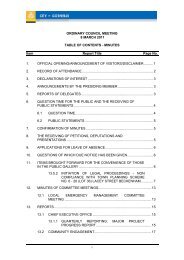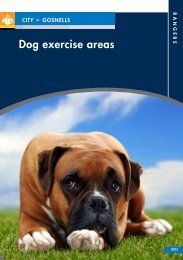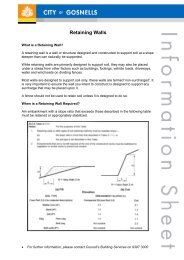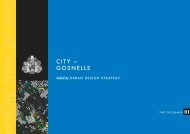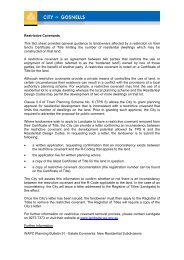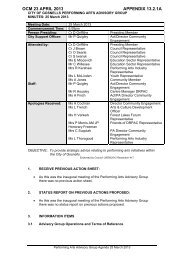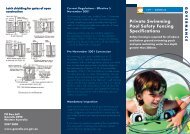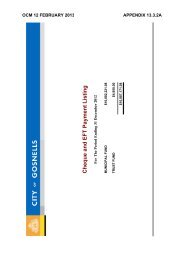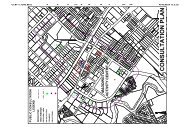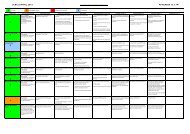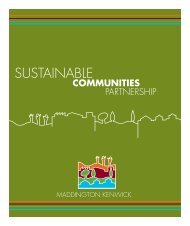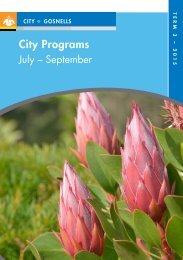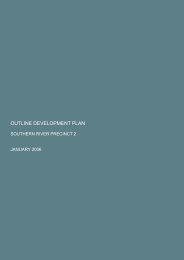Summary - City of Gosnells
Summary - City of Gosnells
Summary - City of Gosnells
You also want an ePaper? Increase the reach of your titles
YUMPU automatically turns print PDFs into web optimized ePapers that Google loves.
Regional Setting 11due to climate change. In perpetuating the same methods <strong>of</strong> dealing with run-<strong>of</strong>f as are currently used in theMKSEA and increasing the conveyance capacity in the area, the negative local effects (dewatering anddegradation <strong>of</strong> valuable plant and animal habitats) and negative downstream effects (pollution <strong>of</strong> the SwanRiver) will be exacerbated.Central to this issue are the predominantly muddy or clay soils and the low-lying topography <strong>of</strong> the MKSEA(Figures 6, 7, 11). The opportunities for both development and the environmentally sustainable treatment <strong>of</strong>run-<strong>of</strong>f water are significantly constrained by such landscapes. Three main methods that are used currently tomanage stormwater on the SCP (that could be used in the MKSEA) and problems associated with them aresummarised below.1. In areas <strong>of</strong> deep sand, the cheapest (and most common) method <strong>of</strong> artificial drainage that is currentlyused on the SCP to prevent the flooding <strong>of</strong> property and infrastructure by the increased volume <strong>of</strong>surface flow produced by development, is to gravity feed this water to the lowest points in the landscape(which are usually existing wetlands or constructed swales). To reduce expenses, the run-<strong>of</strong>f from alarge area is concentrated into the least number <strong>of</strong> basins possible and the receiving basins are excavatedto accommodate the required volumes. If the basins are located in deep sand, the periodic flooding <strong>of</strong>these by large volumes <strong>of</strong> nutrient-enriched, polluted run-<strong>of</strong>f is a practical and cheap method <strong>of</strong> disposal<strong>of</strong> excess water as this water readily infiltrates into the regional groundwater table.However, to disperse the pollution carried in stormwater and to reduce environmental impacts, watersensitive urban design in areas <strong>of</strong> deep sand dictates that excess run-<strong>of</strong>f is not concentrated into a few,large basins but is infiltrated into the groundwater as close as possible to the source <strong>of</strong> the run-<strong>of</strong>f inmany small basins (Monk and Chalmers, 2006). Such infiltration basins, according to best practice, alsorequire regular maintenance to remove gross refuse, sediment, nutrient and pollutant build up andnutrient-stripping vegetation. However, the best practice model for drainage is costly as it requires thatvaluable land be devoted to drainage measures.In the MKSEA, the area <strong>of</strong> the deep sands that could be used for (water sensitive urban design) run-<strong>of</strong>finfiltration areas is limited to a narrow corridor <strong>of</strong> dunes adjacent to Tonkin Highway in Precinct 1 and asmaller area in Precinct 2 at the east end <strong>of</strong> Victoria Rd. There are few, if any, sandy areas suitable forwater sensitive urban design infiltration sites in Precinct 3 <strong>of</strong> the MKSEA.2. The second option for dealing with run-<strong>of</strong>f from development (and this method is most commonly usedin areas <strong>of</strong> clay and mud on the eastern SCP where drainage water will not infiltrate the groundwater) isto direct this run-<strong>of</strong>f into a drains or natural creeks. If creeks are used for this purpose it becomesnecessary to regularly excavate their channels, keep the banks clear <strong>of</strong> natural fringing vegetation and<strong>of</strong>ten straighten these channels and line them with concrete to enable large volumes <strong>of</strong> nutrient enrichedand polluted run-<strong>of</strong>f to be rapidly exported into major watercourses such as the Swan River. Thesepractices contribute to the degradation <strong>of</strong> native fringing vegetation, the destruction <strong>of</strong> native faunahabitat, the spread <strong>of</strong> weeds, and the deterioration in the water quality <strong>of</strong> the creeks and downstreampollution and algal blooms in the Swan River.This type <strong>of</strong> drainage system is currently used throughout Kenwick and Maddington; pollutedstormwater run-<strong>of</strong>f and water from the shallow aquifers intersected by excavated drains are channelledinto Yule Brook and Bickley Brook and hence into the Canning River.3. A third drainage option that has been used on the eastern side <strong>of</strong> the SCP is the excavation <strong>of</strong> largebasins in clay soils to retain the stormwater run-<strong>of</strong>f close to the areas where it was produced. In suchretention basins the stored water evaporates slowly or, in peak rainfall events, some <strong>of</strong> it overflows intothe Swan-Canning River system. Such a drainage basin was excavated in the Woodlupine Brook justwest <strong>of</strong> the MKSEA to receive the run-<strong>of</strong>f from Roe Highway. In seasons <strong>of</strong> peak rainfall, the overflowfrom this system flows downstream to the Canning River. In the best examples <strong>of</strong> such drainageoptions, the water storage basins are vegetated and subsequently provide habitat for water birds andsome natural nutrient stripping by the vegetation.This drainage option does not address the problem <strong>of</strong> reduced groundwater recharge in such catchmentsthat usually impacts adversely on the water requirements <strong>of</strong> groundwater dependent ecosystems. In theMKSEA, as most <strong>of</strong> the land proposed for development lies in the groundwater catchment for BFS 387Tauss, C. and Weston, A.S. (2010). The flora, vegetation and wetlands <strong>of</strong> the Maddington-Kenwick Strategic Employment Area.A survey <strong>of</strong> the rural lands in the vicinity <strong>of</strong> the Greater Brixton Street Wetlands. Report to the <strong>City</strong> <strong>of</strong> <strong>Gosnells</strong>, W.A. Version 18.04.10



